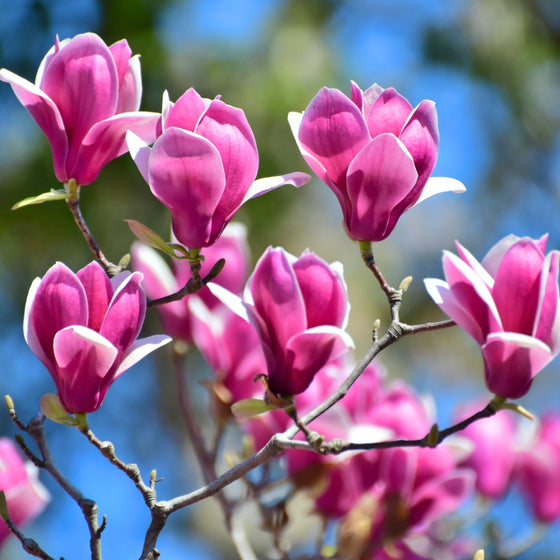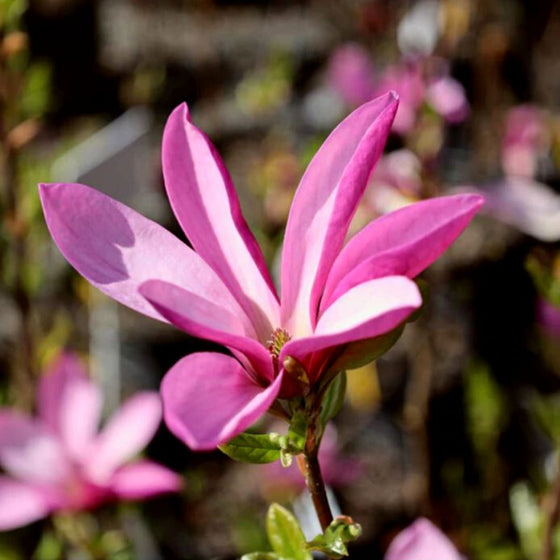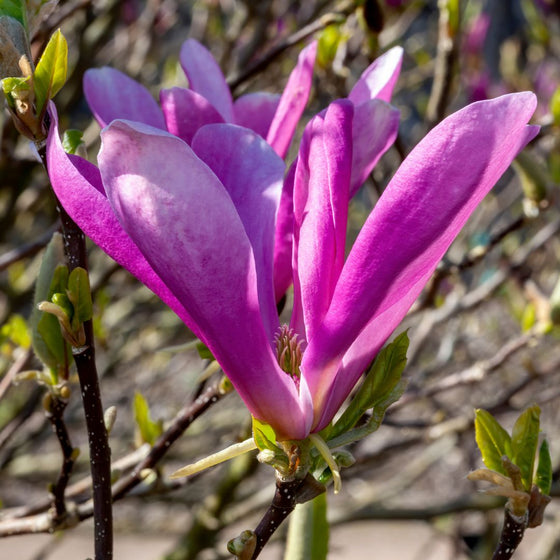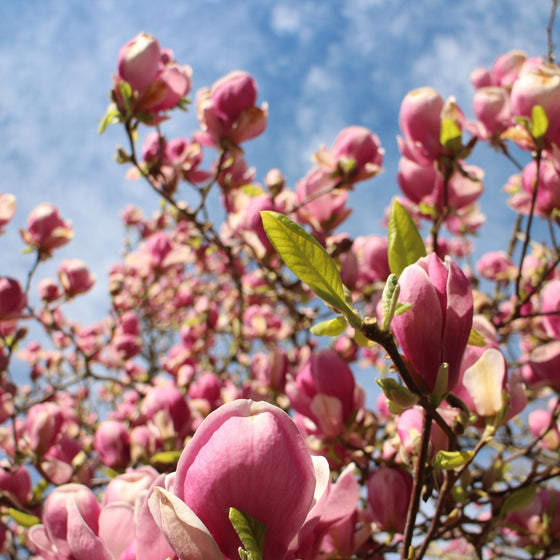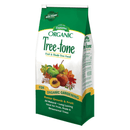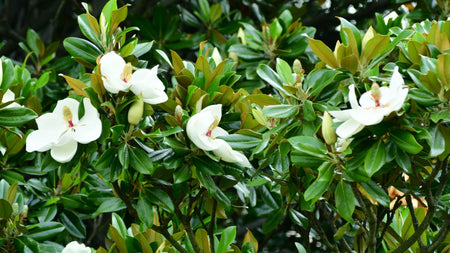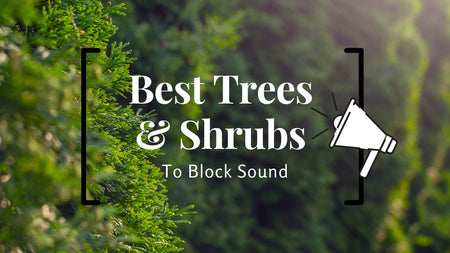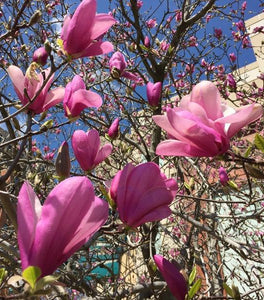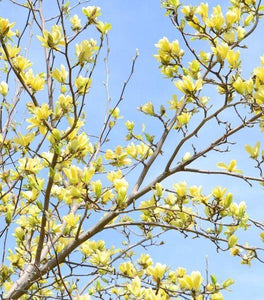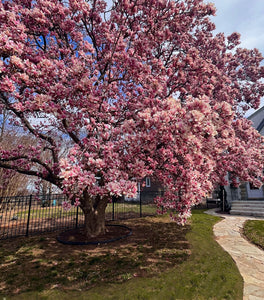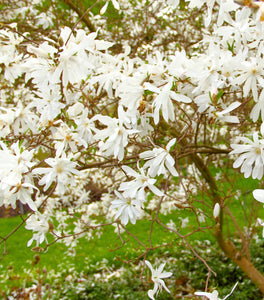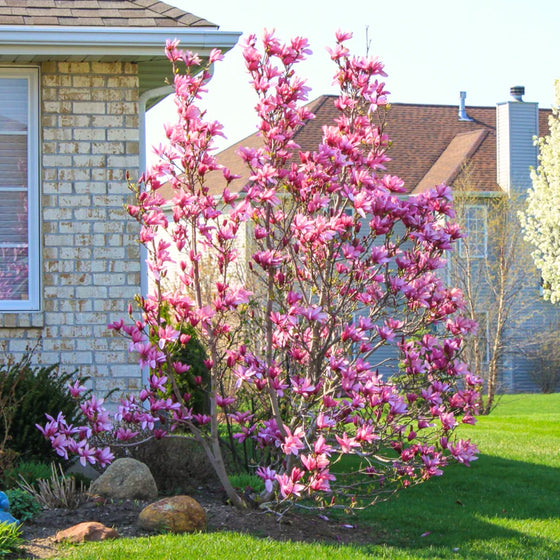
Images Depict Mature Plants
Magnolia Jane Trees for Sale Online
The Magnolia Jane is a stunning, deciduous shrub or small tree that produces large, showy pink to reddish-purple flowers in early spring, adding a pop of color to your landscape. With its beautiful tulip-shaped blooms and elegant branching, this magnolia creates an eye-catching focal point in any garden. Hardy in USDA Zones 4-8, Magnolia Jane grows to a mature size of 10-15 feet tall and 8-12 feet wide, making it an excellent choice for smaller spaces or as an accent tree in larger landscapes. Its compact size and manageable growth habit make it ideal for urban or suburban gardens, where space may be limited.
Known for its cold-hardiness, Magnolia Jane is part of the "Little Girl" hybrid series. It is developed to bloom later in the season, reducing the risk of frost damage to the delicate flowers. The tree thrives in full sun to partial shade and prefers well-drained, slightly acidic soil. Once established, it is relatively low-maintenance, requiring only minimal pruning to maintain its shape. With its long-lasting blooms, Magnolia Jane provides weeks of beauty in early to mid-spring and is a perfect choice for creating seasonal interest in the garden.
In addition to its striking flowers, Magnolia Jane offers attractive dark green foliage that transitions to a rich golden-yellow in the fall, adding multi-season appeal to your landscape. This magnolia also has a strong resistance to pests and diseases, making it an easy-care option for gardeners of all experience levels. Magnolia Jane brings elegance, color, and year-round interest to any garden, whether used as a specimen tree, in a mixed border, or as a flowering accent.
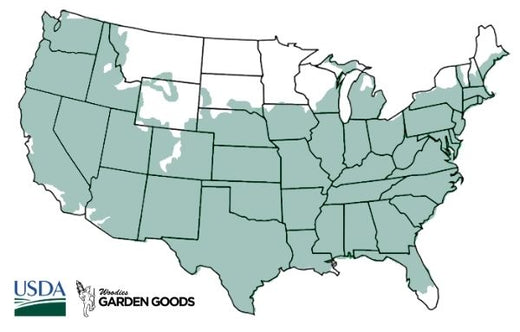
| Hardiness Zone: | 4-8 |
|---|---|
| Mature Height: | 10 to 15 Feet |
| Mature Width: | 8 to 12 Feet |
| Classification: | Broad leaved deciduous small tree, spring flowering |
| Sunlight: | Full sun to part shade |
| Habit: | pyramidal form |
| Foliage: | Dark green, yellow to bronze fall color |
| Flower Color: | Deep Velvety Purple Red |
| Pruning Season: | No pruning needed |
| Soil Condition: | Any well drained soil |
| Water Requirements: | Water well until established |
| Uses: | Tolerates moist soil and full sun. Full sun brings out the best fall color. Will adapt to drier sites. |
How to Care for Magnolia Jane
Make sure to read about the recommended care instructions to keep Magnolia Jane healthy and thriving for years to come!
How do I plant A Magnolia Jane Tree?
To plant a Magnolia Jane tree, start by selecting a location with full sun to partial shade and well-drained, slightly acidic soil. Dig a hole that is twice as wide as the root ball and just as deep to give the roots plenty of space to spread. Place the tree in the hole, ensuring that the top of the root ball is level with the surrounding soil. Backfill the hole with a mix of native soil and compost to improve drainage and nutrient content. After planting, water thoroughly to help settle the soil and establish strong roots. Applying a 2-3 inch layer of mulch around the base of the tree will help retain moisture and regulate soil temperature. Once your Magnolia Jane is planted, water it regularly during the first growing season to encourage healthy root development. This tree is relatively low-maintenance, but ensuring consistent moisture is key to helping it thrive. Avoid overwatering, as Magnolia Jane prefers well-drained soil to prevent root rot. Space your tree at least 10-15 feet away from other plants or structures to allow room for its mature growth, which typically reaches 10-15 feet tall and 8-12 feet wide. With proper planting and care, your Magnolia Jane will reward you with beautiful blooms in early spring and vibrant foliage throughout the seasons.
How do I Water Magnolia Jane?
To water a Magnolia Jane tree effectively, provide deep and consistent moisture, especially during its first growing season. After planting, water deeply at least once or twice a week to help the roots establish. Focus on watering at the base of the tree to ensure the soil around the root zone stays moist but not waterlogged. In periods of hot weather or drought, increase the frequency of watering to prevent the soil from drying out completely. Using a 2-3 inch layer of mulch around the base of the tree will help retain moisture and regulate soil temperature, reducing the need for frequent watering. Once the Magnolia Jane is established, it becomes more drought-tolerant but still benefits from regular watering during dry spells or extended periods of heat. Check the soil moisture regularly by testing the top few inches of soil; if it feels dry, it’s time to water. Avoid letting the soil become soggy, as Magnolia Jane prefers well-drained soil to prevent root rot. Deep watering every 10-14 days is typically sufficient for mature trees, helping them thrive and produce their stunning spring blooms and vibrant foliage throughout the year.
How do I Fertilize Magnolia Jane?
To fertilize a Magnolia Jane tree, start by applying a balanced, slow-release fertilizer in early spring, just before new growth begins. Use a fertilizer specifically formulated for acid-loving plants, such as a 10-10-10 or 12-4-8 mix, to provide essential nutrients like nitrogen, phosphorus, and potassium that support healthy foliage and flower development. Spread the fertilizer evenly around the base of the tree, staying several inches away from the trunk to avoid root burn. Water the tree thoroughly after fertilizing to help the nutrients absorb into the soil and reach the root system. For ongoing care, you can apply another round of fertilizer in late summer to support continued growth and prepare the tree for the next season. Alternatively, adding organic compost or well-rotted manure around the base of the tree will help improve soil quality and provide a natural source of nutrients. Be careful not to over-fertilize, as this can lead to excessive foliage growth at the expense of blooms. Regular fertilization, paired with proper watering, ensures your Magnolia Jane thrives and produces its signature showy blooms year after year.

How do I Prune Magnolia Jane Trees?
Pruning a Magnolia Jane tree is essential for maintaining its shape and promoting healthy growth, but it should be done with care. The best time to prune is in late spring or early summer, right after the tree has finished blooming. Start by removing any dead, damaged, or diseased branches using clean, sharp pruning shears. Focus on thinning out overcrowded branches to improve air circulation and sunlight penetration, which helps prevent disease and encourages better flower production. Be careful not to over-prune, as Magnolia Jane trees bloom on old wood, and cutting too much may reduce the number of flowers for the next season. When pruning your Magnolia Jane, it’s important to retain its natural shape, which is typically rounded or vase-like. Trim back any branches that are growing unevenly or crossing over each other, but avoid heavy pruning, as this tree benefits from a lighter touch. Regularly removing weak or wayward branches helps maintain the tree’s form and health. Minimal pruning is usually needed once the tree is mature, as Magnolia Jane tends to grow in a neat, manageable habit. With proper pruning practices, your tree will continue to thrive, producing its beautiful tulip-shaped blooms each spring while maintaining an attractive structure in your landscape.

